冀教版八年级上册 Unit 6 Lesson 34 Flying Donuts 课件 (共15张PPT)
文档属性
| 名称 | 冀教版八年级上册 Unit 6 Lesson 34 Flying Donuts 课件 (共15张PPT) |  | |
| 格式 | ppt | ||
| 文件大小 | 213.5KB | ||
| 资源类型 | 教案 | ||
| 版本资源 | 冀教版 | ||
| 科目 | 英语 | ||
| 更新时间 | 2022-10-08 14:15:10 | ||
图片预览


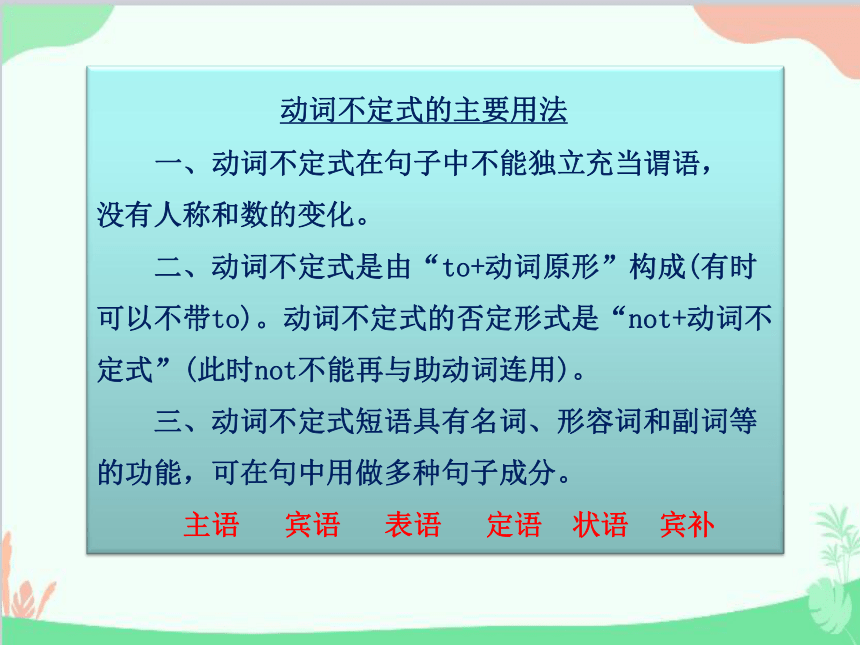
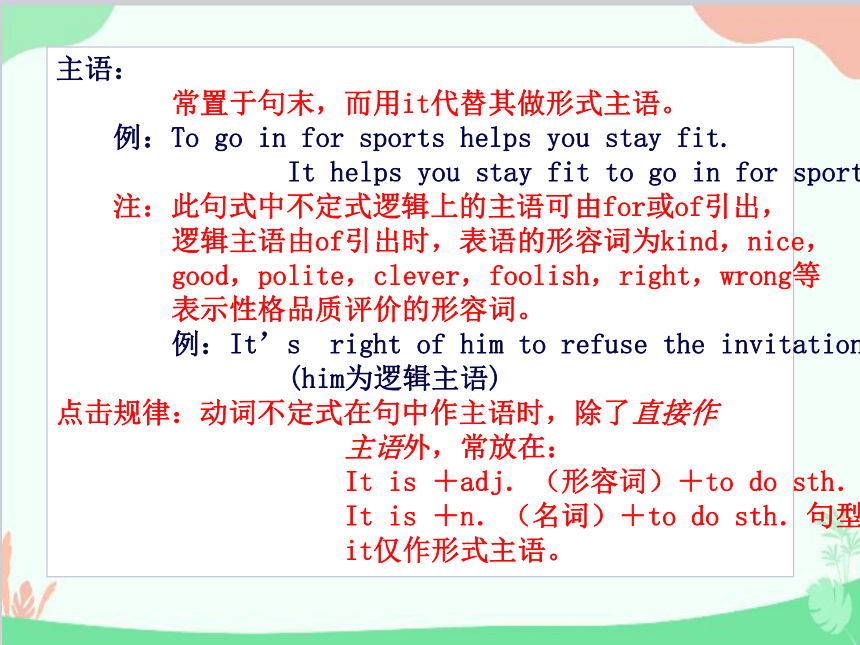
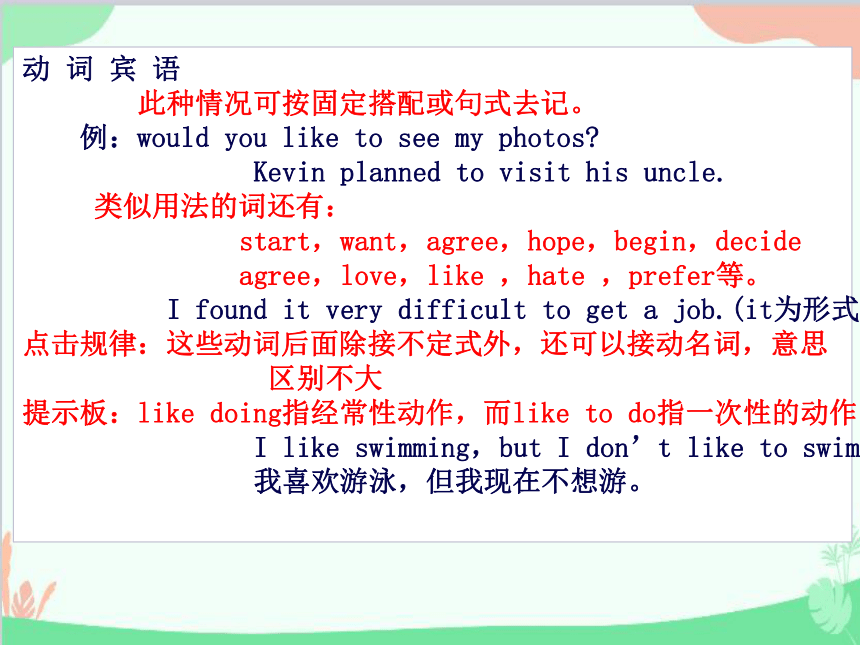
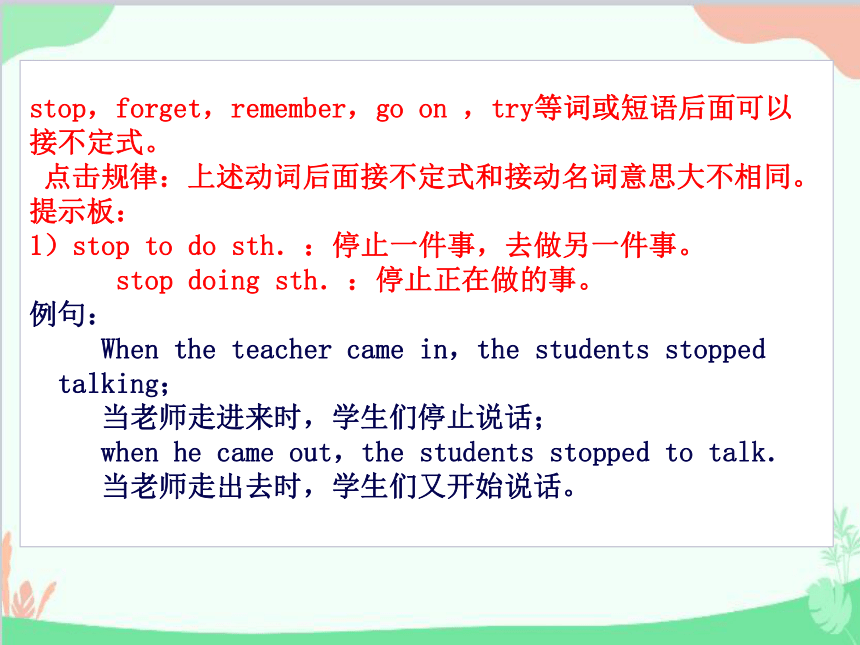
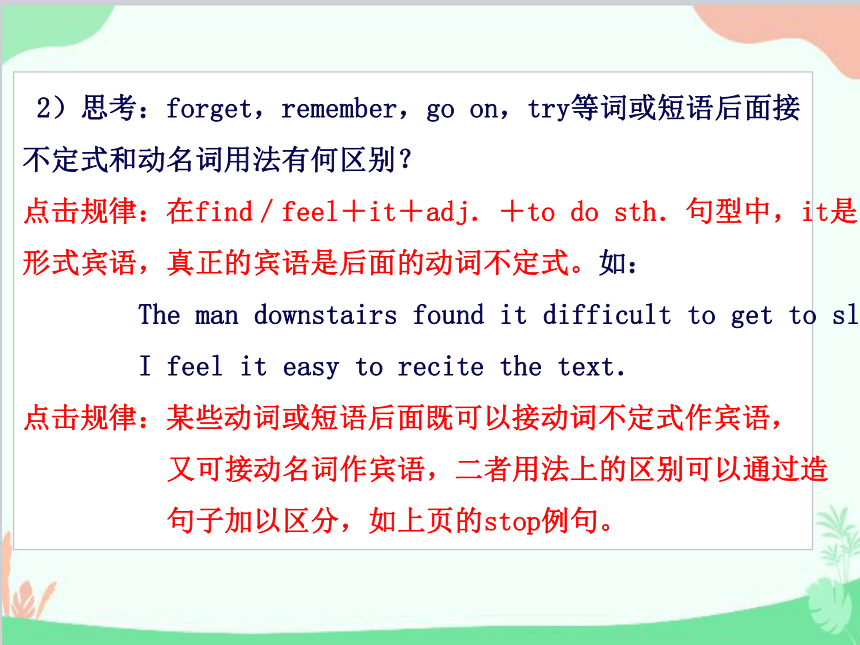
文档简介
(共15张PPT)
动词不定式
概说
动词不定式(to do)是初中英语课的
一个重点,也是中考要考查的一个项目。
动词不定式属于非谓语动词的一种形式,
很多同学经常把它和谓语动词混在一起,
掌握起来有困难。下面我们对动词不定
式的用法做简单归纳,帮助同学们记忆 。
动词不定式的主要用法
一、动词不定式在句子中不能独立充当谓语,
没有人称和数的变化。
二、动词不定式是由“to+动词原形”构成(有时
可以不带to)。动词不定式的否定形式是“not+动词不
定式”(此时not不能再与助动词连用)。
三、动词不定式短语具有名词、形容词和副词等
的功能,可在句中用做多种句子成分。
主语 宾语 表语 定语 状语 宾补
主语:
常置于句末,而用it代替其做形式主语。
例:To go in for sports helps you stay fit.
It helps you stay fit to go in for sports.
注:此句式中不定式逻辑上的主语可由for或of引出,
逻辑主语由of引出时,表语的形容词为kind,nice,
good,polite,clever,foolish,right,wrong等
表示性格品质评价的形容词。
例:It’s right of him to refuse the invitation.
(him为逻辑主语)
点击规律:动词不定式在句中作主语时,除了直接作
主语外,常放在:
It is +adj.(形容词)+to do sth.或
It is +n.(名词)+to do sth.句型中,
it仅作形式主语。
动 词 宾 语
此种情况可按固定搭配或句式去记。
例:would you like to see my photos
Kevin planned to visit his uncle.
类似用法的词还有:
start,want,agree,hope,begin,decide
agree,love,like ,hate ,prefer等。
I found it very difficult to get a job.(it为形式宾语)
点击规律:这些动词后面除接不定式外,还可以接动名词,意思
区别不大
提示板:like doing指经常性动作,而like to do指一次性的动作。
I like swimming,but I don’t like to swim now.
我喜欢游泳,但我现在不想游。
stop,forget,remember,go on ,try等词或短语后面可以
接不定式。
点击规律:上述动词后面接不定式和接动名词意思大不相同。
提示板:
1)stop to do sth.:停止一件事,去做另一件事。
stop doing sth.:停止正在做的事。
例句:
When the teacher came in,the students stopped
talking;
当老师走进来时,学生们停止说话;
when he came out,the students stopped to talk.
当老师走出去时,学生们又开始说话。
2)思考:forget,remember,go on,try等词或短语后面接
不定式和动名词用法有何区别?
点击规律:在find/feel+it+adj.+to do sth.句型中,it是
形式宾语,真正的宾语是后面的动词不定式。如:
The man downstairs found it difficult to get to sleep.
I feel it easy to recite the text.
点击规律:某些动词或短语后面既可以接动词不定式作宾语,
又可接动名词作宾语,二者用法上的区别可以通过造
句子加以区分,如上页的stop例句。
表 语
放在连系动词be后面
例句:His wish is to become a scientist.
Our duty is to protect the enviroment.
The first important thing is to save the
soldiers’ lives.
当务之急是抢救战士们的生命。
点击规律:动词不定式在句中作表语时,通常对连系
动词前面的名词进行诠释说明。
返回
定 语
动词不定式做定语放在所修饰的名词 、代词的后面。例:
He is the first person to sail around the world.
I have a lot of work to do.
The doctor said he could do nothing to help the boy.
点击规律:动词不定式若在句中作定语,常放在被修饰的名词、
代词之后。
提示板:如果动词不定式和前面所修饰的词构成动宾关系,
且动词是不及物动词,切记不要忘掉后面的介词。如:
I have a small bedroom to live in.
Have you got some pens to write with?
作 状 语
a.目的状语:放在go,come,use,live,in order等词后面。
如:
I come to see you.
He runs fast in order to get there in time.
They brought in photos of their families for me to look at
b.原因状语:放在sorry,glad,surprised, disappointed,
excited等词后面。(有些资料上把这类称为不定式在
表示心理、情感、评价等的形容词后,对其进行补充说明,
作形容词补足语)如:
I am glad to see you here.
I am sorry to trouble you.
c.作结果状语。如:
Some of the apples are hard to reach.
The room is large enough to hold 1000 people.
返回
宾 语 补 足 语
(1)在多数复合宾语及物动词后要带to:
tell,ask,want,order,teach,invite,warn,wish,
help,get,wish,等词后面常接不定式作宾补。例:
I tell him not to go there by bus .
(2)在表示感觉、致使等意义的动词(see,watch,hear,feel,
make,let,have, observe, notice, help等)后
不带to 的不定式作宾补。如:
The boss makes them work 16 hours a day.
提示板:若变成被动语态,在上述结构中,不定式符号to要加上。
如:
They are made to work 16 hours a day by the boss.
“疑问词+不定式”用法
不定式前可带what,who,which,where,when,how,
whose,等疑问词,这种不定式短语在句中作宾语、宾语补足语、
主语等。例:
He didn’t tell me where to go. (直宾)
I don’t know what to say now.(宾语)
I don't know what to do next.(宾语)
He taught us how to use the computer.(宾语补足语)
It's still a question how to get there.(主语)
在初中阶段还涉及到“不定式被动语态一般式(to be+过去分词)”
例:There are twenty more trees to be planted.
根据句意,用括号内所给动词的适当形式填空。
1.Would you like_____(go)shopping with me?
2.It took us half an hour_____(work)out the problem.
3.He is old enough_____(join)the army.
4.I feel strange_____(have)a twin sister.
5.They prefer_____(stay)at home rather than go out.
6.We saw them_____(come)into the room just now.
7.I am sorry.I forgot_____(tell)you the news.
8.His plan is_____(spend)a few days in the mountains.
9.Have you decided which one_____(choose)?
10.Do you know when_____(start)?
11.He is too weak_____(carry)the big stone.
to go 宾语
to work 主语
to join 结果状语
to have 形容词补足语(原)
to stay 宾语
to come 宾补
to tell 宾语
to spend 表语
to choose 定语
to start 不定式短语作宾语
to carry 结果状语
Thank you!
动词不定式
概说
动词不定式(to do)是初中英语课的
一个重点,也是中考要考查的一个项目。
动词不定式属于非谓语动词的一种形式,
很多同学经常把它和谓语动词混在一起,
掌握起来有困难。下面我们对动词不定
式的用法做简单归纳,帮助同学们记忆 。
动词不定式的主要用法
一、动词不定式在句子中不能独立充当谓语,
没有人称和数的变化。
二、动词不定式是由“to+动词原形”构成(有时
可以不带to)。动词不定式的否定形式是“not+动词不
定式”(此时not不能再与助动词连用)。
三、动词不定式短语具有名词、形容词和副词等
的功能,可在句中用做多种句子成分。
主语 宾语 表语 定语 状语 宾补
主语:
常置于句末,而用it代替其做形式主语。
例:To go in for sports helps you stay fit.
It helps you stay fit to go in for sports.
注:此句式中不定式逻辑上的主语可由for或of引出,
逻辑主语由of引出时,表语的形容词为kind,nice,
good,polite,clever,foolish,right,wrong等
表示性格品质评价的形容词。
例:It’s right of him to refuse the invitation.
(him为逻辑主语)
点击规律:动词不定式在句中作主语时,除了直接作
主语外,常放在:
It is +adj.(形容词)+to do sth.或
It is +n.(名词)+to do sth.句型中,
it仅作形式主语。
动 词 宾 语
此种情况可按固定搭配或句式去记。
例:would you like to see my photos
Kevin planned to visit his uncle.
类似用法的词还有:
start,want,agree,hope,begin,decide
agree,love,like ,hate ,prefer等。
I found it very difficult to get a job.(it为形式宾语)
点击规律:这些动词后面除接不定式外,还可以接动名词,意思
区别不大
提示板:like doing指经常性动作,而like to do指一次性的动作。
I like swimming,but I don’t like to swim now.
我喜欢游泳,但我现在不想游。
stop,forget,remember,go on ,try等词或短语后面可以
接不定式。
点击规律:上述动词后面接不定式和接动名词意思大不相同。
提示板:
1)stop to do sth.:停止一件事,去做另一件事。
stop doing sth.:停止正在做的事。
例句:
When the teacher came in,the students stopped
talking;
当老师走进来时,学生们停止说话;
when he came out,the students stopped to talk.
当老师走出去时,学生们又开始说话。
2)思考:forget,remember,go on,try等词或短语后面接
不定式和动名词用法有何区别?
点击规律:在find/feel+it+adj.+to do sth.句型中,it是
形式宾语,真正的宾语是后面的动词不定式。如:
The man downstairs found it difficult to get to sleep.
I feel it easy to recite the text.
点击规律:某些动词或短语后面既可以接动词不定式作宾语,
又可接动名词作宾语,二者用法上的区别可以通过造
句子加以区分,如上页的stop例句。
表 语
放在连系动词be后面
例句:His wish is to become a scientist.
Our duty is to protect the enviroment.
The first important thing is to save the
soldiers’ lives.
当务之急是抢救战士们的生命。
点击规律:动词不定式在句中作表语时,通常对连系
动词前面的名词进行诠释说明。
返回
定 语
动词不定式做定语放在所修饰的名词 、代词的后面。例:
He is the first person to sail around the world.
I have a lot of work to do.
The doctor said he could do nothing to help the boy.
点击规律:动词不定式若在句中作定语,常放在被修饰的名词、
代词之后。
提示板:如果动词不定式和前面所修饰的词构成动宾关系,
且动词是不及物动词,切记不要忘掉后面的介词。如:
I have a small bedroom to live in.
Have you got some pens to write with?
作 状 语
a.目的状语:放在go,come,use,live,in order等词后面。
如:
I come to see you.
He runs fast in order to get there in time.
They brought in photos of their families for me to look at
b.原因状语:放在sorry,glad,surprised, disappointed,
excited等词后面。(有些资料上把这类称为不定式在
表示心理、情感、评价等的形容词后,对其进行补充说明,
作形容词补足语)如:
I am glad to see you here.
I am sorry to trouble you.
c.作结果状语。如:
Some of the apples are hard to reach.
The room is large enough to hold 1000 people.
返回
宾 语 补 足 语
(1)在多数复合宾语及物动词后要带to:
tell,ask,want,order,teach,invite,warn,wish,
help,get,wish,等词后面常接不定式作宾补。例:
I tell him not to go there by bus .
(2)在表示感觉、致使等意义的动词(see,watch,hear,feel,
make,let,have, observe, notice, help等)后
不带to 的不定式作宾补。如:
The boss makes them work 16 hours a day.
提示板:若变成被动语态,在上述结构中,不定式符号to要加上。
如:
They are made to work 16 hours a day by the boss.
“疑问词+不定式”用法
不定式前可带what,who,which,where,when,how,
whose,等疑问词,这种不定式短语在句中作宾语、宾语补足语、
主语等。例:
He didn’t tell me where to go. (直宾)
I don’t know what to say now.(宾语)
I don't know what to do next.(宾语)
He taught us how to use the computer.(宾语补足语)
It's still a question how to get there.(主语)
在初中阶段还涉及到“不定式被动语态一般式(to be+过去分词)”
例:There are twenty more trees to be planted.
根据句意,用括号内所给动词的适当形式填空。
1.Would you like_____(go)shopping with me?
2.It took us half an hour_____(work)out the problem.
3.He is old enough_____(join)the army.
4.I feel strange_____(have)a twin sister.
5.They prefer_____(stay)at home rather than go out.
6.We saw them_____(come)into the room just now.
7.I am sorry.I forgot_____(tell)you the news.
8.His plan is_____(spend)a few days in the mountains.
9.Have you decided which one_____(choose)?
10.Do you know when_____(start)?
11.He is too weak_____(carry)the big stone.
to go 宾语
to work 主语
to join 结果状语
to have 形容词补足语(原)
to stay 宾语
to come 宾补
to tell 宾语
to spend 表语
to choose 定语
to start 不定式短语作宾语
to carry 结果状语
Thank you!
同课章节目录
- Unit 1 Me and My Class
- Lesson 1 Back to School!
- Lesson 2 Many Faces, One Picture
- Lesson 3 Getting to Know You!
- Lesson 4 Best Friends
- Lesson 5 Meet Ms. Liu
- Lesson 6 Jenny's Week
- Unit 2 My Favourite School Subject
- Lesson 7 Don't Be Late for Class!
- Lesson 8 E-mail Helpers!
- Lesson 9 I Don't Want to Miss Geography !
- Lesson 10 Looking for Lisa
- Lesson 11 Lily Learns about China !
- Lesson 12 Karen's Hair Stood Up!
- Unit Review
- Unit 3 Families Celebrate Togethe
- Lesson 13 I Love Autumn
- Lesson 14 Happy Memories
- Lesson 15 A Present for Li Ming!
- Lesson 16 Happy Thanksgiving!
- Lesson 17 Presents from Canada!
- Lesson 18 Li Ming's Birthday
- Unit Review
- Unit 4 My Neighbourhood
- Lesson 19 The Best Neighourhood
- Lesson 20 No Stopping!
- Lesson 21 Eat a Donut and Turn Right
- Lesson 22 I Like My Neighbourhood
- Lesson 23 People in My Neighbourhood
- Lesson 24 I Need a Map!
- Unit Review
- Unit 5 My Future
- Lesson 25 I Want to Be a Teacher!
- Lesson 26 What Will I Be ?
- Lesson 27 What's Your Advice?
- Lesson 28 Rich or Poor? It Doesn't Matter!
- Lesson 29 Our Ambitions and Dreams
- Lesson 30 A Famous Friend?
- Unit Review
- Unit 6 Go With Transportation !
- Lesson 31 How Do You Travel ?
- Lesson 32 Trains Go Faster !
- Lesson 33 Life on Wheels
- Lesson 34 Flying Donuts
- Lesson 35 Future Transportation
- Lesson 36 Clean Cars ?
- Unit Review
- Unit 7 Enjoy Your Hobby
- Lesson 37 What's Your Hobby ?
- Lesson 38 Hobbies Are Fun!
- Lesson 39 Danny's Hobby
- Lesson 40 What's Paul's Hobby?
- Lesson 41 Show and Tell!
- Lesson 42 The New Club
- Unit Review
- Unit 8 Celebrating Me
- Lesson 43 What Makes You Unique?
- Lesson 44 Georgia Plays Basketball
- Lesson 45 Be Yourself !
- Lesson 46 My Dream
- Lesson 47 I Made It !
- Lesson 48 Li Ming's Report
- Unit Review
